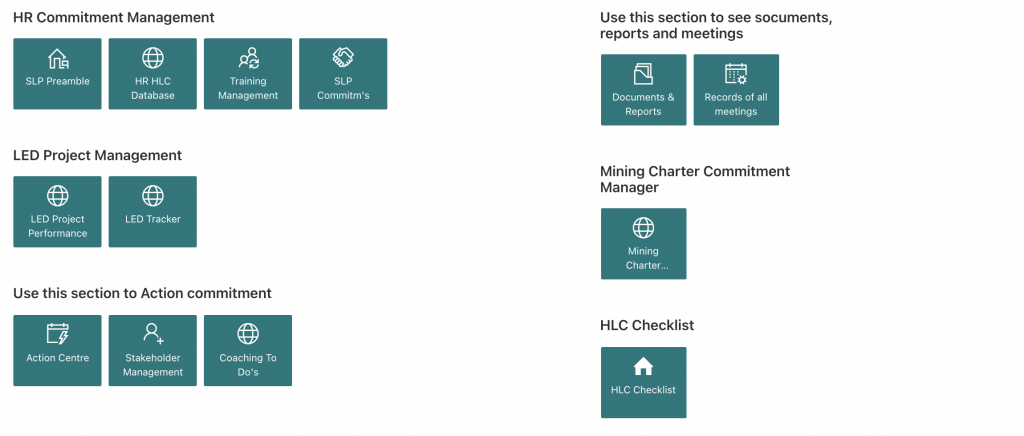Our dedicated mission is to address your specific Social and Labour and Mining Charter challenges. We specialize in assisting mining companies that may be facing non-compliance issues and guide them towards effective strategies for filling those gaps. Our extensive experience with the Department of Mineral Resources and Energy (DMRE) has shown that they are not overly strict, but occasionally require better comprehension of Mining Charter regulations and broader legislation. We understand that navigating the regulatory landscape can be perplexing, which is why we achieve negotiated settlements for most challenges. Our collaborative approach ensures we find mutually beneficial solutions for your compliance needs. Let us help you overcome your social and labor challenges, delivering tangible results for your mining operations.
We are here to uncomplicate your Social License to Operate. To this end, we provide advisory and software services to assist in resolving any SLP and/or Mining Charter challenge that you may have.
Click here to read how we assist with your Social and Labour Plan and Mining Charter compliance
- We guide you to understand your own unique social and labour plan and mining charter compliance commitments. Yes, unbelievable as it may sound, every mine has it’s own unique mining charter.
- We use our database of all social and labour plan and mining charter obligations published by the DMRE and we decode your commitments.
- We agree your own unique social and labour plan and mining charter obligations and we do a gap analysis between your performance and commitments.
- We then agree a strategy for you to close those gaps.
Four things we do quick and we do well….
SLP Mining Charter reports, templates and scorecardsExtensive and Secure Software Solutions
Click below what you need help with….
Demand letters from DMRE? We assist…
The nature of the letter will determine its urgency. If its a letter to threaten you to close your mine because you are uncompliant, urgent consultations with the DMRE is necessary. If it’s a letter to inform you of an audit, then engage the DMRE with a view to establish the areas that will be covered in the audit. If on the other hand its a letter pointing out that you need to update certain aspects of your SLP, be it complaints from communities, be it an LED project that you have not completed, engage constructively. Remember, you have rights, that your contract with the DMRE is your last approved SLP, excluding new regulations that has come about.
Know your rights and obligation
Under the Mineral and Petroleum Resources Development Act (MPRDA), Social and Labour Plan (SLP), and the Mining Charter, mining rights include the right to apply for and conduct mining operations, provided all legal and regulatory requirements are met. You are entitled to fair administrative processes and secure tenure, with rights to appeal unfair decisions. Obligations include compliance with MPRDA provisions, implementing an SLP addressing human resource and local economic development, adhering to Mining Charter targets, and conducting regular environmental assessments. You must ensure health and safety measures, engage in corporate social responsibility initiatives, and maintain transparent records and reporting to the Department of Mineral Resources and Energy (DMRE). Compliance ensures responsible, sustainable mining operations in line with South African laws and regulations.
Let’s develop your new SLP
In this regard, experience is significant. We have been invovled with SLP’s since 2004. We have seen the migration of the Social and Labour Plan from what appeared at first to be complex documents, seemintly fraught with potholes, to a more transparent and easy to understand document. (See some of our projects)
To compile a new Social and Labour Plan (SLP) for our clients, we follow a comprehensive approach that includes understanding the specific requirements of the Mining Charter and the Mineral and Petroleum Resources Development Act (MPRDA). We conduct a thorough needs analysis, engage with stakeholders, and perform socio-economic impact assessments. We then develop tailored strategies for local economic development, skills development, and community projects. Our process ensures full compliance with regulatory standards, promoting sustainable development and fostering positive community relations. (Click for more information)
Developing a Social and Labour Plan (SLP) involves several key steps. Initially, compliance requirements are reviewed, followed by stakeholder consultation to address impacts. An impact assessment is conducted, aligning compliance and mitigation measures, setting priorities based on cost-effectiveness. Plans are documented as per DMR format, submitted for approval, and commitments are tracked post-approval using an SLP Tracker. Click to read more below.
Our approach to co-creating a practical Social Labour Plan with you is the following (+read SLP Guidelines)
Compliance: The first step is to review all the compliance requirements pertaining to developing the SLP.
Consultation: Once we obtained a thorough understanding of all the compliance measures, we can begin with consulting affected stakeholders because we need to work toward establishing the material impacs. These impacts need to be mitigated or enhanced.
Impact Assessment: To a large extent, the compliance categories and aspects set out in the SLP Guidelines dictate the important focus-issues. Compliance issues and on-the-ground impacts mostly overlap because the well-known negative impacts are generally aspects that also need compliance. A SLP is by default a document that dictates how impacts and compliance measures will be mitigated or enhanced. The SLP is therefore the plan that indicates how this needs to be done. Once we identified the impacts and enhancement measures, and evaluated these against the compliance aspects, then priorities is set.
We then evaluate each priority in terms of its cost-effectiveness because practical plans is necessary for each.
Documentation: Once we made a thorough assessment of the priorities of the the SLP, we document the plans in the format that the DMR has prescribed.
Approval: Once the SLP has been compiled, it is submitted to the regional DMR’s offices. Approval is then awaited.
Tracking: Once approved, we assist our clients to track their commitments using our SLP Tracker.

Note that the following are published SLP’s on the internet.
